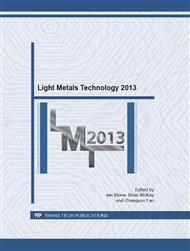p.408
p.413
p.418
p.423
p.429
p.434
p.439
p.444
p.451
Integrated Modeling of Strength Evolution in Al-Mg-Si Alloys during Hot Deformation
Abstract:
In the present work we develop a physically based model of strength evolution during hot deformation of Al-Mg-Si alloys. The goal is to predict a change of material strength taking into account the impact of microchemistry, i.e. the influence of solutes and precipitates on strengthening and softening mechanisms. The material strengthening is considered in the present work in terms of solid solution strengthening (the Labusch-Naborro model), work hardening (the advanced one-parameter Kocks model), as well as precipitation strengthening due to the stress contribution of non-deformable particles, i.e. dispersoids (the Orowan by-pass). The material softening is described by dynamic recovery through thermal activation of dislocation climb. For the precipitation kinetics the computational thermodynamics code MatCalc (Materials Calculator) was used. The model was validated by comparison with experimental data of compression tests of the 6xxx series aluminium alloys and a reasonable agreement of the simulated and measured flow stress curves was found.
Info:
Periodical:
Pages:
429-433
Citation:
Online since:
July 2013
Authors:
Price:
Сopyright:
© 2013 Trans Tech Publications Ltd. All Rights Reserved
Share:
Citation:


